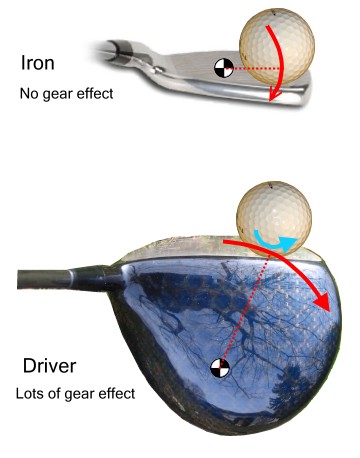S
SteveT
Guest
FYI ... here is an excellent explanation of gear effect for drivers and irons.
Driver gear effect adds another force vector to the ball that may diminish or accentuate D-plane analysis results since it affects the ball spin rate and axis.
Therefore, current D-plane analysis only applies to driver sweet spot Impact. How does TrackMan compensate for off-center driver hits?
By Tutelman -- Design Notes - Golf Physics p2
Gear effect is sidespin which is the result of an off-center hit with a club whose center of gravity is well back from the clubface. Without both these conditions, gear effect does not happen.
Let's see what causes gear effect. In the picture at the right, we have two off-center impacts, one on an iron and the other on a driver. Both are toe impacts, which means it is to the toe side of the center of gravity of the clubhead. (The CG is denoted by the four-quadrant black-and-white circle; it's a pretty common notation for CG.) What does Newton say about such an impact? The CG wants to continue moving forward in a straight line, but there is a force on the clubhead that is off that line. That creates a torque that wants to twist the club. The result is that the CG keeps moving forward, but the club rotates around the CG in a clockwise direction (red arrows).
The CG of the iron is close to the clubface. So, where the clubface and ball meet, this rotation (the red arrow) consists of the clubface "falling away" from the ball. This results in loss of distance (the momentum transfer is not as complete as it should have been), and perhaps the ball flying somwhat to the right as the face opens. But there isn't any special effect on spin.
The driver is a completely different story. Its CG is well behind the clubface. When the driver head rotates around its CG, the whole face of the club moves sideways. Look at the direction of the red arrow where the clubface and ball meet; it is mostly parallel to the clubface, with only a bit of "falling away".
So the club's face is moving to the right while the ball is compressed on it. The result is that the ball starts to rotate so its surface doesn't slide along the clubface; remember it's compressed so sliding is difficult. This rotation is the blue arrow in the picture. If the clubhead is rotating clockwise (as in the picture), then the ball rotates counter-clockwise. It's as if the clubhead and ball were a pair of gears, with their teeth meshing where they meet.
That's why a toe hit with a driver tends to hook. For all the same reasons, a heel hit with a driver tends to slice. You don't have this effect with an iron.

Driver gear effect adds another force vector to the ball that may diminish or accentuate D-plane analysis results since it affects the ball spin rate and axis.
Therefore, current D-plane analysis only applies to driver sweet spot Impact. How does TrackMan compensate for off-center driver hits?
